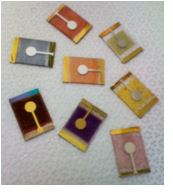L'UMR NIMBE explore et développe des matériaux nanostructurés pour les nouvelles technologies de l'énergie (NTE) :
Batteries
- les électrodes de batteries Li-ion comme des nanoparticules de silicium recouvertes d’une coquille de carbone (équipe LEDNA du NIMBE)
- les générations de batteries post Li-ion (Mg-ion, Li-air…) (équipe LEEL du NIMBE)
- des tapis de nanotubes de carbone alignés (équipe LEDNA du NIMBE) et des matériaux carbonés mésoporeux (équipe LICSEN du NIMBE) pour des électrodes de supercondensateurs
Dispositifs photovoltaïques (PV) organique ou hybride :
- cellules PV à base de Perovskite (équipe LICSEN du NIMBE)
- Nanoparticules de silicium dopées ou non incluses dans différentes matrices (équipe LEDNA du NIMBE)
- molécules spécifiques aux couches d’interface de cellules PV organiques
- nanotubes de carbone fonctionnalisés par des chromophores,
- nanoparticules d’oxydes TiO2 dopées ou non en azote pour les cellules solaires à colorants
Hydrogène énergie
- Une méthode spécifique de nanostructuration des polymères reposant sur l’utilisation de rayonnements ionisants (UV ou ions lourds) permet d’obtenir des membranes polymères de piles à combustible basse température radiogreffées pouvant servir d’alternative au nafion, qui est le polymère de référence.
- Une autre activité du NIMBE porte sur la mise au point de catalyseurs pour la réduction de l’oxygène ou l’oxydation de l’hydrogène, indispensables dans les piles à combustible. Le platine est l’élément de référence en matière d’efficacité catalytique, mais il est rare et coûteux. L’objectif est de diminuer la quantité de platine dans les catalyseurs (équipe LEDNA du NIMBE), et même de le remplacer par des catalyseurs alternatifs sans métaux nobles (équipe LICSEN du NIMBE).
E-carburants (électro-carburants)
- L'équipe du LCMCE poursuit des recherches en catalyse pour proposer de nouveaux procédés de production de carburants “verts”, indispensables au transport longue distance, à partir de CO2 et d'hydrogéne et au moyen d'électricité décarbonée (d'origine nucléaire, solaire ou éolien).
UMR NIMBE explores and develops nanostructured materials for new energy technologies (NTE):
Organic or hybrid photovoltaic (PV) devices:
- perovskite PV cells (LICSEN lab @ NIMBE)
- doped or not silicon nanoparticles included in various matrices (LEDNA lab @ NIMBE)
- molecules for interface layers in organic PV cells
- functionalized carbon nanotubes by chromophores
- nitrogen doped TiO2 oxide for dye PV cells (LEDNA lab @ NIMBE)

Batteries
- electrodes of Li-ion batteries, such as silicon nanoparticles coated with a carbon shell,
- next generation of batteries (post Li-ion, like Mg-ion, Li-air…) (LEEL lab @ NIMBE)
- Verticaly aligned carbon nanotube (LEDNA lab @ NIMBE) and mesoporous carbon supports (LICSEN lab @ NIMBE) for supercapacitors electrodes
Hydrogen energy
- A specific method for nanostructuring polymers, based on irradiation (by UV or heavy ions), allows to obtain radio-grafted polymers membranes for low temperature fuel cells, as an alternative to nafion, the reference polymer.
- An important part of the activity of IRAMIS covers the development of catalysts for the reduction of oxygen or oxidation of hydrogen that are required in fuel cells. Platinum is the reference element in catalytic efficiency, but it is rare and expensive. The objective is to reduce the amount of platinum in the catalyst (LEDNA lab @ NIMBE), and even replace it with alternative catalysts without noble metals (LICSEN lab @ NIMBE), for example based on functionalized carbon nanotubes.
E-fuels (electro-fuels)
- The LCMCE team perform research in catalysis to propose new processes for the production of “green” fuels, essential for long-distance transports, from CO2 and hydrogen and by means of carbon-free electricity (from nuclear, solar or wind).

